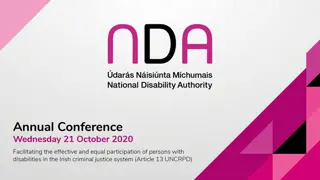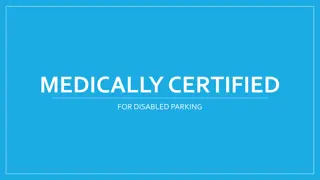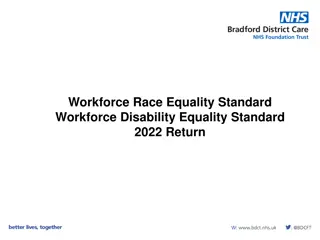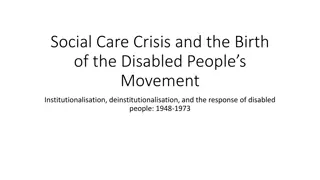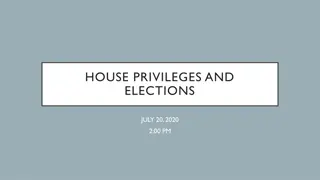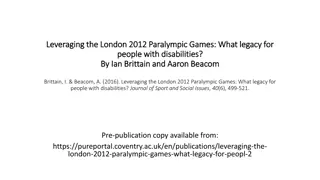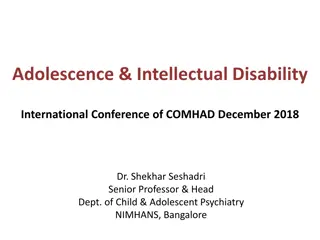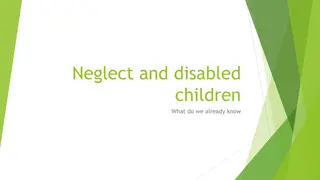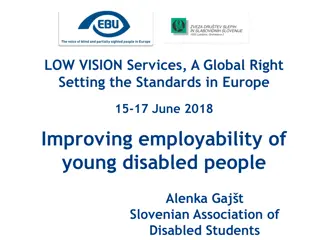
Understanding Child Find: Educational Evaluations, Disproportionality, and More
Explore topics such as racial disproportionality, independent educational evaluations, delays due to Response to Intervention, and the importance of early intervention in the context of Child Find. Learn about disability classification data and the rights of parents regarding educational evaluations. Gain insights into addressing issues like seclusion, restraint, suspension, and the school-to-prison pipeline.
Download Presentation

Please find below an Image/Link to download the presentation.
The content on the website is provided AS IS for your information and personal use only. It may not be sold, licensed, or shared on other websites without obtaining consent from the author. If you encounter any issues during the download, it is possible that the publisher has removed the file from their server.
You are allowed to download the files provided on this website for personal or commercial use, subject to the condition that they are used lawfully. All files are the property of their respective owners.
The content on the website is provided AS IS for your information and personal use only. It may not be sold, licensed, or shared on other websites without obtaining consent from the author.
E N D
Presentation Transcript
TOPICS Child Find: Racial Disproportionality Independent Educational Evaluations Delays due to Response to Intervention Individualized Education Program Seclusion and Restraint Suspension Racial Disproportionality School to Prison Pipeline Filing a Complaint Complaint Investigator Due Process Hearing Officer District Court Resolution
CHILD FIND Importance of Early Intervention Importance of Early Intervention School District s Responsibility School District s Responsibility
MATTHEW EFFECT For unto every one that hath shall be given, and he shall have abundance: but from For unto every one that hath shall be given, and he shall have abundance: but from him that hath not shall be taken away even that which he hath. him that hath not shall be taken away even that which he hath.
DISABILITY CLASSIFICATION DATA (2010) African African- -American American (14 % of population) (14 % of population) 32.5 % 16.5 % Hispanic Hispanic (22 (22 % of population) % of population) 12.8 % 18.1 % White White (55 % of population) (55 % of population) 51.4 % 61.6 % Mental Retardation Speech or Language Impairment Visual Impairment 16.3 % 28.5 % 26.7 % 11.9 % 52.3 % 56.7 % Emotional Disturbance Orthopedic 14.2 % 18.9 % 20.6 % 9.8 % 61.4 % 68.4 % Other Health Impairment Specific Learning Disability 21.2 % 23.8 % 52.1 % Multiple Disabilities 18.8 % 16.2 % 14.0 % 23.7 % 12.6 % 24.9 % 11.3 % 9.6 % 64.8 % 52.9 % 69.7 % 59.4 % Hearing Impairment Autism Developmental Delay
INDEPENDENT EDUCATIONAL EVALUATIONS 34 C.F.R. 34 C.F.R. 300.502 300.502 ( (b b) Parent right to evaluation at public expense. ) Parent right to evaluation at public expense. (1) A parent has the right to an independent educational evaluation at public (1) A parent has the right to an independent educational evaluation at public expense if the parent expense if the parent disagrees disagrees with an evaluation obtained by the public agency with an evaluation obtained by the public agency (2) Parent is entitled to evaluation at public expense unless agency demonstrates (2) Parent is entitled to evaluation at public expense unless agency demonstrates at a due process hearing that its evaluation is at a due process hearing that its evaluation is appropriate appropriate (4) The public agency may ask for the parent s reason why he or she objects to (4) The public agency may ask for the parent s reason why he or she objects to the public evaluation. However, the public agency the public evaluation. However, the public agency may not require the parent to provide an explanation provide an explanation and may not unreasonably delay and may not unreasonably delay may not require the parent to (5) A parent is entitled to only one independent educational evaluation at public (5) A parent is entitled to only one independent educational evaluation at public expense each time the public agency conducts an evaluation with which the expense each time the public agency conducts an evaluation with which the parent disagrees. parent disagrees.
1977 TO 2004 Exclusively used the severe discrepancy model. Exclusively used the severe discrepancy model. Missed some children with average or below average IQs who struggled with reading.
2001 Congress enacted No Child Left Behind. Congress enacted No Child Left Behind. Focus of NCLB is proficiency as measured by single test. Purpose is to raise Focus of NCLB is proficiency as measured by single test. Purpose is to raise performance of school as a whole, not to provide individualized services to a performance of school as a whole, not to provide individualized services to a child. child.
2004 Congress amended IDEA to require school districts to offer Response to Intervention Congress amended IDEA to require school districts to offer Response to Intervention approach to determine which students have learning disabilities. approach to determine which students have learning disabilities. School districts allowed to use IDEA resources to help children who cannot meet proficiency standards.
SECLUSION AND RESTRAINT CP 0231 CP 0231- -2012(Heir Force Community School)(Cline) 2012(Heir Force Community School)(Cline) Very very strong findings criticizing a community school s use of restraint But contrast with Columbus complaint (CP 0203 But contrast with Columbus complaint (CP 0203- -2012)(Cline) 2012)(Cline)
CP 0231-2012 (HEIR FORCE COMMUNITY SCHOOL) Student was only in first grade but being subject to restraint frequently. School threatened parent with disenrollment if parents contested suspension. Investigator documented a teacher noting that he or she actually sat on the student's chest which investigator describes as "potentially lethal." Complaint filed with Children's Services over alleged abuse of child.
SUSPENSION DATA African African- -American American 0.36 % 2.38 % 2.78 % 4.11 % White White 0.2 % 0.74 % 0.67 % 1.09 % 1998-99 2002-03 2005-06 2007-08
OVERVIEW OF COMPLAINT RESOLUTIONS May 2012 to May 2013: May 2012 to May 2013: 81 Complaints 51 Pro-parent/student (63 %) 30 Pro-district (37 %) Significant variation by investigator and by school district Significant variation by investigator and by school district
EXAMPLES OF SUCCESSFUL ISSUES IN COMPLAINTS 1. 1. Who is in attendance at IEP meetings Who is in attendance at IEP meetings 2. 2. Lack of parent Lack of parent c communication/progress ommunication/progress r reports eports 3. 3. Poor scheduling of meetings with Parents Poor scheduling of meetings with Parents 4. 4. Poorly Written IEPs Poorly Written IEPs 5. 5. Failing to have continuum of alternative placements Failing to have continuum of alternative placements 6. 6. Improper use of seclusion and restraint Improper use of seclusion and restraint 7. 7. Obligations of community schools Obligations of community schools 8. 8. Failing to conduct evaluations/child find Failing to conduct evaluations/child find
BLAME THE MOTHER CP 0144 CP 0144- -2012 (North Canton)( 2012 (North Canton)(Rensch District blamed parent for effectively unilaterally removing the student from school rather than acknowledging severity of student s medical problems. Rensch) )
IHO AND SLRO OPINIONS 1. 1. Procedural violations but no finding of substantive harm School district removed services to allegedly help student function more independently 2. 2. SE 2609 SE 2609- -2011, SLRO 2609 2011, SLRO 2609- -2011 (pro 2011 (pro- -District)(won t discuss further) District)(won t discuss further) Longstanding dispute by parent whose child was sent to Educare District court cases under Horen v. Bd. of Educ. of City of Toledo Public School District 3. 3. SE 2662 SE 2662- -2012, SLRO 2662 2012, SLRO 2662- -2012 (pro 2012 (pro- -Student) Student) Found no FAPE for two years but still ordered no compensatory education IHO tried to apply new Ohio seclusion rules before they had gone into effect 4. 4. SE 2702 SE 2702- -2012 (pro 2012 (pro- -District) District) Pro se parent who isn t able to follow rules 5. 5. SE 2802 SE 2802- -2013 (pro 2013 (pro- -Student, in part) Student, in part) Blamed mother but provided some relief for being forced to home school 6. 6. SE 2804 SE 2804- -2013 (pro 2013 (pro- -District) District) Blamed mother Refuses to provide relief despite procedural violations SE 2603 SE 2603- -2011, SLRO 2603 2011, SLRO 2603- -2012 (pro 2012 (pro- -District) District)
DISTRICT COURT CASES Reversed IHO or SLRO: Reversed IHO or SLRO: Gibson v. Forest Hills (transition services) P.C. v. Miford Exempted Village Schools (change in placement) Affirmed SLRO: Affirmed SLRO: Horen v. Toledo School District (Educare case) Hupp v. Switzerland of Ohio Local School District (FAPE issues; procedural errors but no substantive harm) T.J. v. Winton Woods School District (SLRO reversed IHO; district court affirmed SLRO)(same lawyer who brought P.C. v. Milford case)
CONCLUSION These cases provide stark evidence of: These cases provide stark evidence of: school districts writing entirely inadequate IEPs, Blaming mothers for children s challenges, and use of entirely inappropriate seclusion and restraint. Racial and class disproportionality reflected in Ohio, as in nation. Racial and class disproportionality reflected in Ohio, as in nation. What can we do to improve professionalism of IHO and SLRO opinions in What can we do to improve professionalism of IHO and SLRO opinions in Ohio? Ohio? What can we do to overcome race and class bias in special education What can we do to overcome race and class bias in special education process? process?

